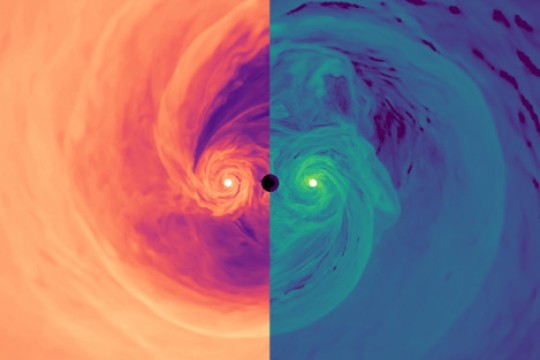News
Manuela Campanelli
-
April 13, 2022

Bringing Supermassive Black Hole Mergers to Light
AAS NOVA reports on research conducted by Manuela Campanelli, professor in the School of Mathematical Sciences and director of the Center for Computational Relativity and Gravitation.
-
January 21, 2022

Researchers detect 1st merger between black holes with eccentric orbits
Space.com reports on research led by RIT scientists on a merger of two black holes with eccentric orbits.
-
January 20, 2022

RIT scientists confirm a highly eccentric black hole merger for the first time
For the first time, scientists believe they have detected a merger of two black holes with eccentric orbits. According to a paper published in Nature Astronomy by researchers from RIT and the University of Florida, this can help explain how some of the previous black hole mergers are much heavier than previously thought possible.
-
July 8, 2021

RIT hosting virtual conference on compact binary mergers for computational astrophysicists
RIT’s Center for Computational Relativity and Gravitation is hosting a virtual conference to discuss the cutting-edge science of binary neutron star and neutron star-black hole mergers.
-
April 28, 2021

RIT researchers use Frontera supercomputer to study eccentric binary black hole mergers
Researchers from RIT’s Center for Computational Relativity and Gravitation are using the world’s most powerful academic supercomputer to perform simulations that will help scientists study eccentric binary black hole mergers.
-
April 21, 2021

Black hole Nobel Prize winner Andrea Ghez is RIT’s 2021 commencement speaker
Andrea Ghez, a 2020 Nobel Prize winner in physics for her research in discovering one of the most exotic phenomena in the universe—the supermassive black hole at the center of our galaxy—will be a 2021 RIT commencement speaker on May 14 and 15. Ghez joins Eric Avar ’90 (industrial design), Nike’s vice president and creative guide of innovation design who was honored with the College of Art and Design Distinguished Alumni Award in 2016, as the university’s first-ever dual commencement speakers.
-
December 8, 2020

Dell Technologies and TACC Fuel Great Innovations
CIO Magazine mentions Manuela Campanelli, professor in the School of Mathematical Sciences, and her work with the TACC Frontera supercomputer.
-
September 30, 2020

RIT Professor Scott Franklin named American Physical Society Fellow
RIT Professor Scott Franklin has been elected a fellow of the American Physical Society. The fellowship is a selective and prestigious recognition by peers for outstanding contributions to physics.
-
May 8, 2020

RIT Honors Distinguished Faculty Awardees for 2020
RIT honored its 2020 class of Distinguished Faculty—Manuela Campanelli, Satish Kandlikar and James Perkins. The Distinguished Professor designation is given to tenured faculty who have shown continued excellence over their careers in teaching, scholarly contributions, lasting contributions in creative and professional work and service to both the university and community.
-
April 22, 2020

NSF funds RIT researchers to develop code for astrophysics and gravitational wave calculations
The National Science Foundation recently awarded researchers at RIT, the University of Illinois at Urbana-Champaign, Louisiana State University, Georgia Tech and West Virginia University grants totaling more than $2.3 million to support further development of the Einstein Toolkit, a community-developed code for simulating the collisions of black holes and neutron stars, as well as supernovas and cosmology.
-
December 12, 2019

RIT and IAR observe pulsars for the first time from South America
A team from RIT and the Instituto Argentino de Radioastronomía (IAR) upgraded two radio telescopes in Argentina that lay dormant for 15 years in order to study pulsars, rapidly rotating neutron stars with intense magnetic fields that emit notably in radio wavelengths. The project is outlined in a new paper published in Astronomy and Astrophysics.
-
October 25, 2019

Shedding light on black holes
The Christian Science Monitor talks to Manuela Campanelli, professor and director of the Center for Computational Relativity and Gravitation.




